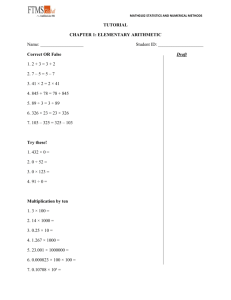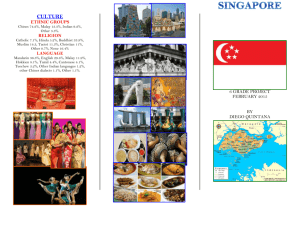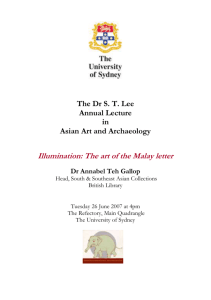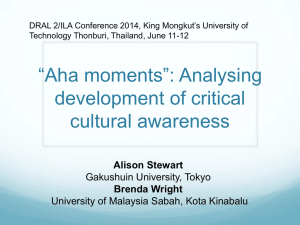The Interpretation of Light in the Exhibition Design Context
advertisement
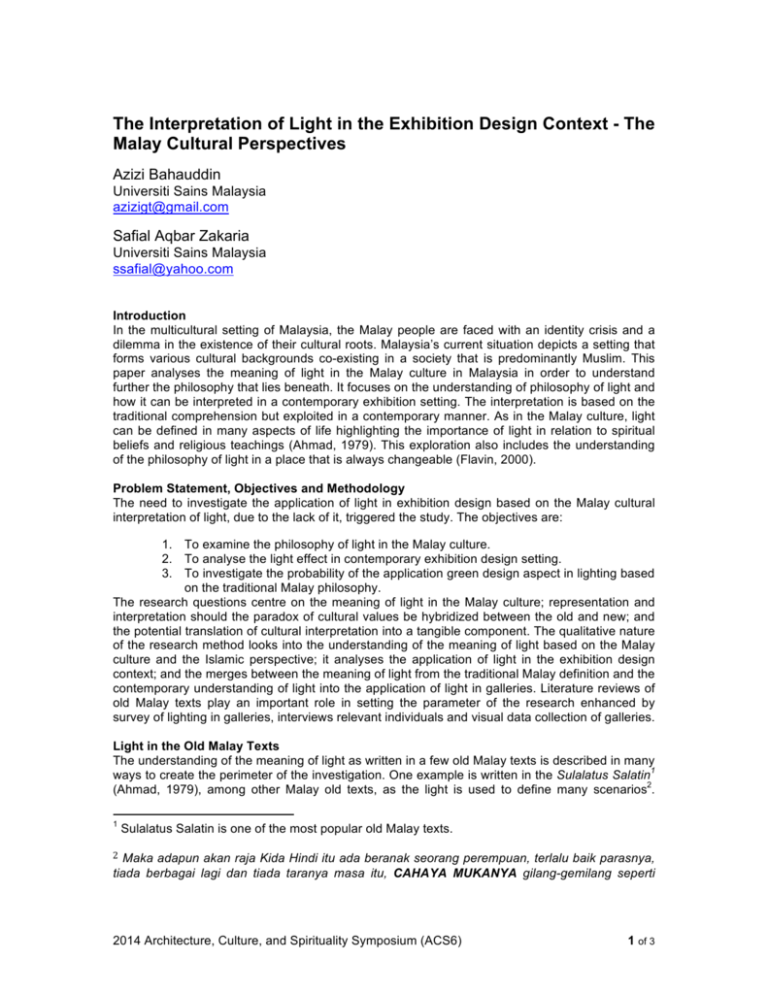
The Interpretation of Light in the Exhibition Design Context - The Malay Cultural Perspectives Azizi Bahauddin Universiti Sains Malaysia azizigt@gmail.com Safial Aqbar Zakaria Universiti Sains Malaysia ssafial@yahoo.com Introduction In the multicultural setting of Malaysia, the Malay people are faced with an identity crisis and a dilemma in the existence of their cultural roots. Malaysia’s current situation depicts a setting that forms various cultural backgrounds co-existing in a society that is predominantly Muslim. This paper analyses the meaning of light in the Malay culture in Malaysia in order to understand further the philosophy that lies beneath. It focuses on the understanding of philosophy of light and how it can be interpreted in a contemporary exhibition setting. The interpretation is based on the traditional comprehension but exploited in a contemporary manner. As in the Malay culture, light can be defined in many aspects of life highlighting the importance of light in relation to spiritual beliefs and religious teachings (Ahmad, 1979). This exploration also includes the understanding of the philosophy of light in a place that is always changeable (Flavin, 2000). Problem Statement, Objectives and Methodology The need to investigate the application of light in exhibition design based on the Malay cultural interpretation of light, due to the lack of it, triggered the study. The objectives are: 1. To examine the philosophy of light in the Malay culture. 2. To analyse the light effect in contemporary exhibition design setting. 3. To investigate the probability of the application green design aspect in lighting based on the traditional Malay philosophy. The research questions centre on the meaning of light in the Malay culture; representation and interpretation should the paradox of cultural values be hybridized between the old and new; and the potential translation of cultural interpretation into a tangible component. The qualitative nature of the research method looks into the understanding of the meaning of light based on the Malay culture and the Islamic perspective; it analyses the application of light in the exhibition design context; and the merges between the meaning of light from the traditional Malay definition and the contemporary understanding of light into the application of light in galleries. Literature reviews of old Malay texts play an important role in setting the parameter of the research enhanced by survey of lighting in galleries, interviews relevant individuals and visual data collection of galleries. Light in the Old Malay Texts The understanding of the meaning of light as written in a few old Malay texts is described in many 1 ways to create the perimeter of the investigation. One example is written in the Sulalatus Salatin 2 (Ahmad, 1979), among other Malay old texts, as the light is used to define many scenarios . 1 Sulalatus Salatin is one of the most popular old Malay texts. 2 Maka adapun akan raja Kida Hindi itu ada beranak seorang perempuan, terlalu baik parasnya, tiada berbagai lagi dan tiada taranya masa itu, CAHAYA MUKANYA gilang-gemilang seperti 2014 Architecture, Culture, and Spirituality Symposium (ACS6) 1 of 3 The word that is used to describe light always points towards someone or something special that posseses the power of magic. Magic and religion are inextricably mixed up in the perception of the Malay folks in the use of the Quran and its verses as charms and spells (Osman, 1989) in describing what light is. Basically, light is seen as something magical or keramat (Titus, 1959). Light in Malay Culture and Islam The study of light and its meanings touches the aspects of religion and spirituality, and their functions in life in the context of the Malay culture. In the study of Malay culture, the scope and extent covers all areas of the Malay world such as Ideas, Norms and Values, Materials and Art (KKBSM, 1983). According to Deraman (1988), the Malay community refers to the Malay world for ingredients of its culture. Consequently, the geographical environment of the Malay community has nurtured the behaviour and thinking of the Malays (Othman, 1993). Deraman (1988) explained that if taken from the viewpoint of religion and beliefs of the Malay community itself, the coming of Islam changed the look and the essence of culture in this region. In Islam, light is symbolic of the existence and greatness of God and serves as a guide to mankind. Allah’s light is a blessing that is beyond compare, a gift or blessing of the highest order and not for everyone. Al-Quran also states that Allah is the light of the heavens and the earth who gives light (PKKM, 2000). Light in Islam has a deep and symbolic meaning that signifies the purity of this religion and strengthened by Motoko (2001) who stated that light is the symbol of life. The existence of light is the closest thing to God for people and for all living things. Llewelyn (2011) believes that in Sufism if humans are unaware of their need then they deny their access to His grace. She believes that the light rises towards light and light comes down upon light. And it is Light upon Light. Exhibition Design Lighting and Green Design Aspect of Lighting An exhibition will not work if a collection is displayed individually or on its own. It requires translation and subject interpretation based on a theme (Bahauddin, 2007). Mohd Sharif (1999) stated that lighting traditionally was an accessory that was employed in a specific corner. In this study, the areas of investigation are the art and science of light in a contemporary exhibition design context with the Malay cultural definition of light used as a catalyst to create and produce a new version of light for galleries. The proposition that was used and believed to move the research is that the agents deploy light in such a way that it not only transmits messages that are sometimes narrative, but also, in a somewhat coded way, has a formative function (Katzberg, 2009). It can be argued that light is being used in innovative ways as a tool by museum staff, artists and other agents to facilitate and guide interpretation (Storey, 2003). The investigation of light as a cultural concept is from a cultural-analytic perspective. The two fields that emerged are cultural analysis and exhibition design studies. All of these considerations contribute to the designing of a lighting prototype based on the Malay cultural understanding on lighting. It will be enhanced further by the knowledge of sustainable design and energy saving light design. Recent development of Organic/Light Emitting Diode (OLED/LED) lights may revolutionize the lighting industries as well as fulfilling the Malay cultural interpretations on lighting. cahaya matahari, dan amat bijaksananya dan sempurna budinya; Puteri Syahrul-Bariyah namanya (p. 4). This is describing about the looks of a princess who has the beauty so bright like the light of the sun. Maka rupa segala senjata seperti hujan yang terlalu lebat, tidaklah tampak awan di langit, oleh kebanyakan kilat CAHAYA senjata itu, maka berbangkitlah lebu duli ke udara, kelam-kabut, siang menjadi malam seperti gerhana matahari (p.12). This is describing about a battle, the weapons that are shining bright light, too bright that one couldn’t even see the clouds in the sky. 2014 Architecture, Culture, and Spirituality Symposium (ACS6) 2 of 3 Conclusions It can be concluded that light should be regarded as the most universal and fundamental of symbols. It plays an important role in symbolising the spiritual and the divine; it is also a form of illumination from the physical and intelligence aspects. In any belief and religion light is the source of goodness and the ultimate reality. Light is knowledge, originality, purity and morality. In Islam, light has its own meaning. It is only a benefit to man and he is forbidden to use it as an object of worship and light is understood as a philosophy of life and its meaning is elevated, based on the Quran, as a guide to its followers. Light in fundamental sciences has been used and adopted by all mankind on earth. Its technology keeps changing. The metaphor that can be derived by light as ‘the soul that sees’, indicates that light is universal and a natural human instinct within us. In other words, as a universal meaning, light here can be concluded as a symbol of illumination in the darkness of life, especially the individual life, a practical function in life and the symbol of holy illumination of a human being’s spirit of truth. The meanings and philosophy of light is extremely symbolic and intrinsic in the Malay community and in Islamic teachings. Presently, light no longer has any connection with beliefs and customs but it is important in the philosophy of religion and life. Light in the Malay culture underlines structural and spiritual knowledge. Beliefs in early Malay culture have been given new interpretations in line with Islamic beliefs and teachings. References Ahmad, A. S. Sulalatus Salatin - Sejarah Melayu. (Kuala Lumpur: DBP, 1979). Bahauddin, A. & Zakaria, S. A. Permanent Exhibition Lighting in Malaysian Museums: A Study of Acceptance and Effects on Visitors. (Penang: International Conference on Built Environment in Developing Countries (ICBEDC), 2007). Deraman, A. A. Falsafah dan Pemikiran Dasar Kebudayaan Kebangsaan. (Kuala Lumpur: Kementerian Kebudayaan dan Pelancongan, 1988.4-6). Flavin, D. The Architecture of Light. (New York: Guggenheim Museum, 2000). rd Gordon, G. Interior Lighting for Designers. (3 Edition). (Canada: John Wiley and Sons, 1995). Katzberg, L.M. Cultures of Light: Contemporary Trends In Museum Exhibition. Thesis: (Amsterdam: University of Amsterdam, 2009). Kementerian Kebudayaan Belia dan Sukan Malaysia (KKBSM). (1983). Dasar, Matlamat dan Strategi Pembinaan Kebudayaan Kebangsaan. (Kuala Lumpur: Kementerian Kebudayaan, Belia dan Sukan. p. 9, 1983). Llewellyn, V. L. The Signs of God. (California: The Golden Sufi Center, 2001). Mohd Sharif, D. Membentuk Pencahayaan. Anjung Seri. (Kuala Lumpur: Karangkraf, pp.134-135, 1999). Motoko, I. Lighting Horizons. (Japan: Rikuyosha Co. Ltd. pp. 7, 11, 177, 2001). Osman, M. T. Malay Folk Beliefs - An Intergration of Disparate Elements. (Kuala Lumpur: Dewan Bahasa dan Pustaka, 1989). Othman, A. H. (1993). Psikologi Melayu. (Kuala Lumpur: Dewan Bahasa dan Pustaka. p. 106, 1993). Storey, S. Lighting. (London: Quadrille, 2003). Titus, M. Islam in India and Pakistan. (Calcutta: Y.M.C. Pub. House, 1959). 2014 Architecture, Culture, and Spirituality Symposium (ACS6) 3 of 3

